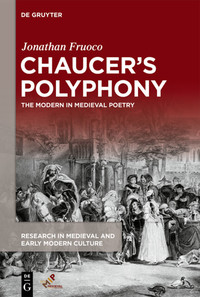
Jonathan Fruoco,
Chaucer’s Polyphony: The Modern in Medieval Poetry.
Berlin/Kalamazoo: De Gruyter - Medieval Institute Publications.
Research in Medieval and Early Modern Culture, 29, 2020.
ISBN: 978-1-5015-1849-2. — 86,95€
Geoffrey Chaucer has long been considered by the critics as the father of English poetry. However, this notion not only tends to forget a huge part of the history of Anglo-Saxon literature but also to ignore the specificities of Chaucer’s style. Indeed, Chaucer’s decision to write in Middle English, in a time when the hegemony of Latin and Old French was undisputed (especially at the court of Edward III and Richard II), was consistent with an intellectual movement that was trying to give back to European vernaculars the prestige necessary to a genuine cultural production, which eventually led to the emergence of romance and of the modern novel. As a result, if Chaucer cannot be thought of as the father of English poetry, he is, however, the father of English prose and one of the main artisans of what Mikhail Bakhtin called the polyphonic novel.
Contents
Preface VII
Notes on the Texts and Translations XI
Abbreviations of Chaucer’s Works XIII
Introduction 1
Chapter 1 Polyphony and Multilingualism in Medieval England 19
- England in the First Days of Old English 24
- Norman Invasion, Multilingualism, and Chaucer’s English 27
Chapter 2 Fin’amor, Stil Novo: Chaucer’s Early Influences 37
- Chrétien de Troyes and the Novelistic Genre 38
- From Chrétien to the Roman de la Rose 45
- Dolce Stil Novo 55
- Chaucer’s First Influences 61
Chapter 3 Narrative Evolution and New Discursive Strategies 65
- The Book of the Duchess 66
- The House of Fame 74
- From Anelida and Arcite to The Parliament of Fowls 88
Chapter 4 Troilus and Criseyde and the Ambiguity of Double Enunciation 95
- Reprocessing Boccaccio’s Filostrato 96
- Double Enunciation: Introducing Dante in Il Filostrato 101
- Dialogism and Mediation 112
- Resisting Closure and Refusing Judgment 119
Chapter 5 Hybridization and the Legend of Chaucer’s Inventiveness 127
- Dream Vision and Narrative Poetry 130
- The Legend of Good Women and Chaucer’s Exercise in Style 136
- Counterbalancing Pathos with Comedy 147
- From Parody to Irony 154
- Narrative Posture and Ironic Conclusion 160
Chapter 6 Extradiegetic Dialogue in The Canterbury Tales 167
- General Prologue: Characterization, Drama, and the Theatrical 170
- Dialogism in The Canterbury Tales and the Chaucer Pilgrim 177
- Extradiegetic Dialogue 181
Conclusion 205
Bibliography 209
- Archival Sources 209
- Primary Sources 209
- Secondary Sources 210
Index 221
- Names and Works 221
- Themes and Concepts 226